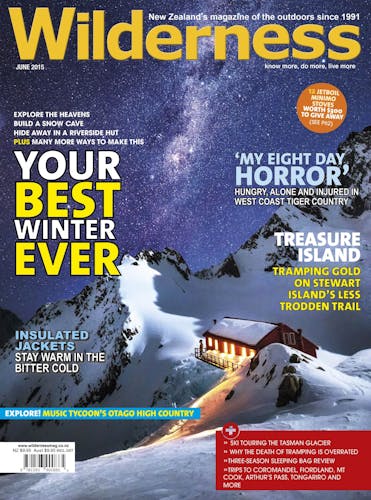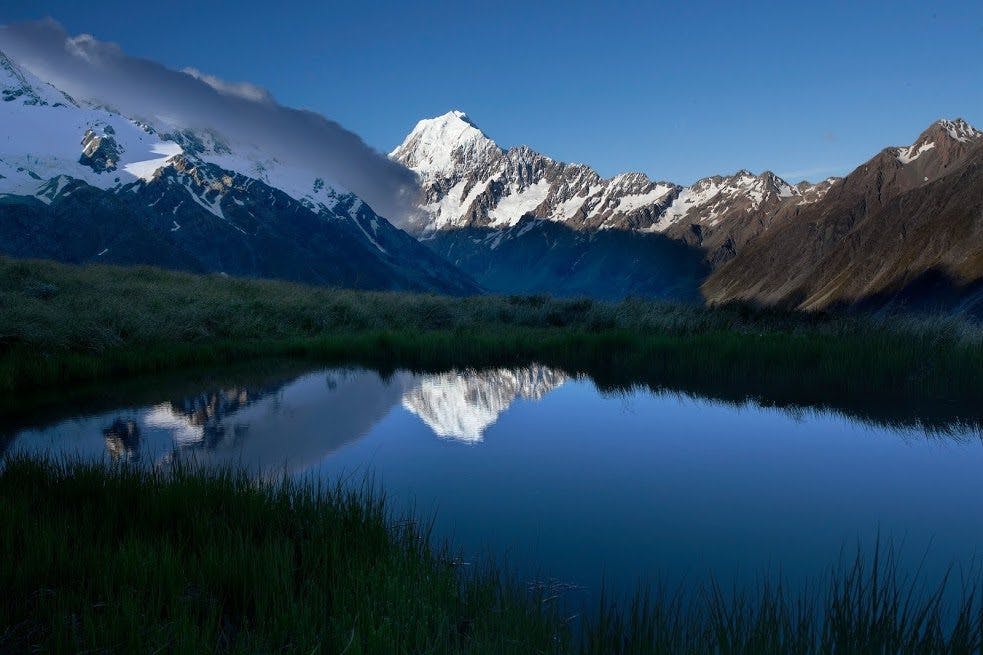- Distance
- 3.76km
- Time
- Sealy Tarns, 1.5hr; Tarns to Mueller Hut, 1.5hr
- Grade
- Moderate
- Accom.
- Mueller Hut, 28 bunks
- Access
- Hooker Valley Rd end
- Map
- BX15
Mueller Hut, Aoraki/Mt Cook National Park / moderate
Visiting the Mt Cook region can often be a lucky dip. Depending on the vagaries of the weather, your journey there can either be a disappointing detour into dense cloud which obscures any chance of sighting New Zealand’s highest mountain, or, if you’re fortunate, a sublime climb into a postcard perfect paradise of snow, ice, rock and general alpine goodness. I experienced both.
My morning was spent waiting for the weather to break in the plush Unwin Lodge and talking to two women fresh off the summit slopes of Aoraki/Mt Cook.
At midday, the clouds parted like a curtain, enough to encourage this dubious, Doubting Thomas into his car. Enough to see him drive the final few kilometres up to the Hermitage for an intriguing exploration of the Sir Edmund Hillary Alpine Centre. By mid-afternoon, Aoraki had shed its cloak and was dominating the head of the Hooker Valley.
While hundreds of day-walkers were treading the tourist trail toward Aoraki, I donned some trail runners, packed a Thermos and a tripod, and headed up the hill. The first 10 minutes on a stony path were quickly dispensed with. From the base of the climb up onto the Sealy Range, a series of chunky wooden steps soon became a real test for my fitness: thighs aching and lungs bursting, .
Up here it was sensory overload – in my right ear was the persistent roar of churning water exiting a melt water lake, swollen milky grey. In my left ear, the thunder of ice falling off the face of Sefton. Below, the tourists were minuscule ants marching to Kea Point. Aoraki stood head and shoulders above all. A kea circled the sky above – it was shaping up to be a magical day.
Higher up, there were no more staircases or handrails. Most of the tourists had turned around at Sealy Tarns. Careful footing was required to balance movement over the large boulder field, before slogging up a tedious slope of slushy snow. Marker poles sidled along to the main ridgeline, then led around to the shiny red hangar that is Mueller Hut. I chatted with the hut warden and watched gliders playing the thermals over the Southern Alps.
It was great to be back here, after two decades. I recall my first visit as a young and eager tramper – it was my 25th birthday. I was camping alone in a cheap A-frame tent; the regular avalanches on Mt Sefton keeping me awake. An awe-inspiring sunrise over Aoraki had me reaching for my camera. Several months after this first visit, the summit ice cap broke away and took 10m off New Zealand’s altitude. Millions of tonnes of debris fell into the Tasman Valley at speeds reaching up to 300km/h. Climbers in a hut 5km away felt the air blast.
Mueller Hut is now in its fifth incarnation. In 1915, the government built the first hut above Mueller Glacier to encourage skiing. A replacement hut was constructed by 1950, but was soon swept away by an avalanche. Remnant materials were recovered to erect a temporary bivouac. In 1953, a better hut was built at a safer site. After half a century, DOC saw the need to better accommodate the increasing traffic and the current commodious hut was constructed in 2003, opened by Sir Ed Hillary himself, occupying a prime piece of real estate on a sloping snow plateau, flat and white like my favourite coffee.
Time to climb down, I told myself, to the undeniable pull of hot showers and coffee. It was late in the day, as I tentatively kicked my shoes into the snow, losing altitude fast. A strange sound emanated from the mountainside, melancholic and minor key. It was, I eventually discovered, a lone Israeli backpacker playing his flute, while waiting for his wife to join him.
At the tarns, I photographed the iconic Mt Cook buttercups, before the knee-jarring descent began. I was struggling to concentrate on steep snowgrass and rock. The last light of day was kissing the top of Aoraki when I dropped down into the deep shadows of Hooker Valley.
Back at the car, I headed south along the shores of Lake Pukaki, radio blaring. Half a dozen rabbits raced over the road, as I sped off into the night. Aoraki was a pastel peach pyramid in my rear-vision mirror, refusing to be subdued by the darkness, insisting we draw our eyes ever upward. Without a doubt I shall return.








